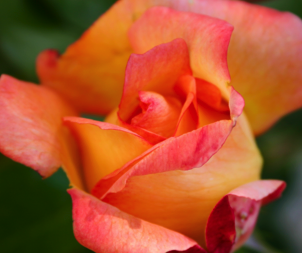A Guide to Planting Roses Correctly New easy care roses, beautiful, repeat blooming and fragrant – climbers, shrubs and ground covers are the essence of the June garden. Prior 2000, many landscape designers and home owners had stopped planting roses. They were “too much work”, “the leaves turn black and fall off”, “too many chemicals needed to make them beautiful”. The old fashioned roses needed too much care. In 2000 along came a game changer, the ‘Knock-Out Rose’® a shrub rose, with many fragrant blooms and disease resistant foliage. The foliage looks healthy and glossy throughout the growing season. The flowers do not require dead heading, although they are more attractive if deadheaded. They have resistance to the common diseases of the old fashioned roses. Meaning they do not require the use of toxic fungicides to keep healthy and look beautiful. The ‘Knock-Out Rose’® re-blooms throughout the summer, fall and into winter. It starts blooming in mid-May and flowers strongly through late June. They take a summer holiday and begin blooming again in mid-August, where they again bloom for 5 to 6 weeks. Most gardeners would be thrilled with a plant that blooms for 10 to 12 weeks. But, they are not finished, the show isn’t over, resting through October, they often begin blooming again in mid-November where they can bloom until late December. I’ve deadheaded mine the day before Christmas as I didn’t want pink flowers next to my holly and red berries. Thorns, all roses have them, but the ‘Knock-Out Rose’® has fewer and they are large, so easily avoidable and they are less sharp than the thorns of other roses. What about color? I should have planted the ‘Knock-Out Rose’® a red rose with a full rose flower instead of the equally lovely ‘Pink Knock-Out Rose’® as they would look great next to my red holly berries in December. ‘Blushing Knock-Out Rose’® is pink with an open flower, ‘Pink double Knock-Out Rose’® is pink with a full rose flower, ‘Rainbow Knock-Out Rose’® is multi-colored with a yellow center and pink flowers, ‘Sunny Knock-Out Rose’® is the newest introduction a yellow rose shrub. Size, these are not small plants, these roses grow 3’ to 4’ high, and 3’ to 4’ wide. They have full foliage from the base of the plant and at the top surrounding the roses with lovely foliage. What about an easy care climbing rose? Last night, when closing a second story window I was delighted by the fragrance of our climbing rose ‘New Dawn’ drifting in on the night air. ‘New Dawn’ like the ‘Knock-Out Rose’® series is very disease resistant. When I plant these at clients homes I first construct a strong trellis or arbor as this is a big climber with strong stems. It grows to 12’ high or higher and 8’ to 10’ wide. It is a repeat bloom, blooming from mid- May through early July and again in September. The flowers are a delicate pink with a good rose fragrance. No room for such large roses in your garden? You will love the ‘Drift Rose’®, growing to only 18” high and 2’-3’ feet wide, these roses find a home in even the smallest of gardens. These are in the same family as the ‘Knock-Out Rose’® series and re-bloom with the same frequency. At clients’ homes I often plant these along front walkways or at the edges of larger planting beds. ‘Drift Rose’® comes in several colors, apricot, coral, peach, pink and red. Sun, all roses need full sun. In our front garden the ‘Knock-Out Rose’® have nearly full sun with dappled shade in the late afternoon. These roses are lovely, but to see what these roses can really look like see our roses in the back gardens, they have full sun, with southern and western exposure. Insects, all roses are food for the Japanese and Asiatic beetles, the most common pest of roses. The beetles appear at the beginning of July, and eat the rose foliage leaving large holes, in years of heavy infestation they can leave a rose nearly defoliated. Check roses beginning at the end of June and remove the beetles every day, the beetles are only around for about two weeks. To remove the beetles, pick them off and put them into a jar that you have filled with kitchen dish detergent and water. They drown in the soapy water and you have protected the beauty of your roses. Deer, they do eat the rose flowers, but not usually the foliage. In areas of very heavy deer browse problems the roses must be protected. The climbing rose is often a good choice as the deer only eat the lower branches. You will have roses at the tops of the climbers where the deer can’t reach. I’ve planted all of these roses in areas of moderate deer browse without protection and have found the deer are actually ‘dead heading’ the roses for us, while leaving us many blooms to enjoy. Fertilizer, roses need to be fertilized. My fertilizer schedule for roses starts in mid-March, I apply a ½ cup of Epsom salts, the kind you buy at the drugstore for soaking sore muscles. Sprinkle the ½ cup of Epsom salts on the soil surrounding the base of the rose plant. The Epsom salts contains magnesium sulfate. Both magnesium and sulfur are important nutrients for plants and roses especially respond to it. In mid-April I apply a rose fertilizer such as Espoma ‘Rose-Tone’, I apply it again in early July. Rose1Roses purchased in plastic pots can be planted in spring through the early fall. Planting them now and watering well through the summer will give you a reason to love roses next June. Read more on How to Plant Roses Right
0 Comments
Your comment will be posted after it is approved.
Leave a Reply. |

 RSS Feed
RSS Feed